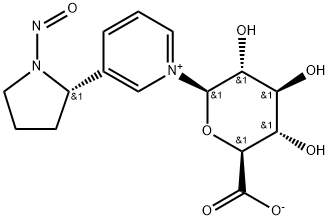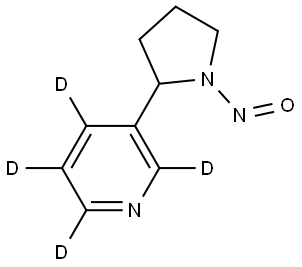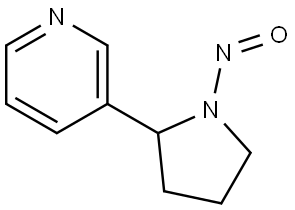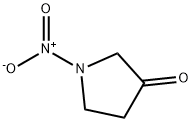N-NITROSOPYRROLIDINE
Synonym(s):N-Nitrosopyrrolidine;NPYR
- CAS NO.:930-55-2
- Empirical Formula: C4H8N2O
- Molecular Weight: 100.12
- MDL number: MFCD00003166
- EINECS: 213-218-8
- SAFETY DATA SHEET (SDS)
- Update Date: 2024-12-18 14:15:32

What is N-NITROSOPYRROLIDINE?
Description
N-Nitrosopyrrolidine (NPYR) is a nitrosamine compound that is used primarily as a research chemical and is not produced commercially. There is the possibility of generating NPYR after frying in dry-cured bacon. The major amine precursors to NPYR in cooked bacon are free proline in the adipose tissue and to a lesser extent, collagenous connective tissues. When proline peptides were heated with nitrite at pH 3.4, small amounts of NPYR were formed from all tested peptides. There are several potential sources of exposure of man to this group of potent carcinogens. Certain foods were thought to be derived from the interaction of nitrite with secondary amines in the food, either spontaneously or by the agency of bacteria. Recently the possibility that nitrosamines may be formed from secondary amines and nitrite in the gastrointestinal tract has been explored. The acid conditions that prevail in the human stomach favor the nitrosation of dimethylamine. In addition, at neutral pH, many secondary amines can be nitrosated by nitrite or nitrate in the presence of intestinal bacteria, or the cecal contents of the rat, and soluble enzymes which catalyze the N-nitrosation of several secondary amines have been extracted from two microorganisms. The rate of nitrosamine formation depends greatly on the basicity of the amine; the less basic amines such as diphenylamine and pyrrolidine are nitrosated far more readily than the strongly basic dimethylamine and diethylamine.
Chemical properties
Light-Yellow Oil
Chemical properties
N-Nitrosopyrrolidine is a yellow liquid.
The Uses of N-NITROSOPYRROLIDINE
One of the N-nitroso compounds (NOCs) implicated in human colon carcinogenesis, but the toxicological mechanisms involved have not been elucidated.
The Uses of N-NITROSOPYRROLIDINE
1-Nitrosopyrrolidine is one of the N-nitroso compounds (NOCs) implicated in human colon carcinogenesis (1,2,3) but the toxicological mechanisms involved have not been elucidated. Drinking water contaminant candidate list 3 (CCL 3) compound as per United States Environmental Protection Agency (EPA), environmental, and food contaminants.
Definition
ChEBI: N-Nitrosopyrrolidine is a member of pyrrolidines.
General Description
Yellow liquid found in certain food products and tobacco smoke. Probably a carcinogen.
Air & Water Reactions
Soluble in water.
Reactivity Profile
A cyclic nitrosamine. Nitrated organics, such as N-NITROSOPYRROLIDINE, range from slight to strong oxidizing agents. If mixed with reducing agents, including hydrides, sulfides and nitrides, they may begin a vigorous reaction.
Health Hazard
ACUTE/CHRONIC HAZARDS: Flammable.
Fire Hazard
Combustible.
Safety Profile
Confirmed carcinogen with experimental carcinogenic, neoplastigenic, and tumorigenic data. Poison by ingestion and subcutaneous routes. Human mutation data reported. When heated to decomposition it emits toxic fumes of NOx. See also N-NITROSO COMPOUNDS.
Potential Exposure
N-Nitrosopyrrolidine is a cyclic nitrosamine and a research chemical. Not commercially produced in the U.S.
Carcinogenicity
N-Nitrosopyrrolidine is reasonably anticipated to be a human carcinogen based on sufficient evidence of carcinogenicity from studies in experimental animals.
Environmental Fate
It is a yellow liquid at room temperature. It is totally soluble in water with solubility of 1.00×10+6 mg l-1 and also is soluble in organic liquids and lipids. Log Pow is -0.19 that expected to move readily from water to soil, sediment, or biota. According to Henry’s law constant 4.89×10-8 atmm3 mol-1 and vapor pressure 0.06 mmHg in 20 ℃, volatilization from water and solid surface is expected to be rapid and an important fate process.
Shipping
UN2810 Toxic liquids, organic, n.o.s., Hazard Class: 6.1; Labels: 6.1-Poisonous materials, Technical Name Required. UN3082 Environmentally hazardous substances, liquid, n.o.s., Hazard Class: 9; Labels: 9-Miscellaneous hazardous material, Technical Name Required liquid, n.o.s., Hazard Class: 9; Labels: 9-Miscellaneous hazardous material, Technical Name Required
Toxicity evaluation
2-OHTHF and several other reactive electrophilic intermediates can bind with proteins and form DNA adducts mainly with guanines.
Incompatibilities
Incompatible with oxidizers (chlorates, nitrates, peroxides, permanganates, perchlorates, chlorine, bromine, fluorine, etc.); contact may cause fires or explosions. Keep away from alkaline materials, strong bases, strong acids, oxoacids, epoxides.
Waste Disposal
Under 40 CFR 261.5 small quantity generators of this waste may qualify for partial exclusion from hazardous waste regulations. Consult with environmental regulatory agencies for guidance on acceptable disposal practices. Generators of waste containing this contaminant (≥100 kg/mo) must conform with EPA regulations governing storage, transportation, treatment, and waste disposal.
Properties of N-NITROSOPYRROLIDINE
| Boiling point: | 214 °C(lit.) |
| Density | 1.085 g/mL at 25 °C(lit.) |
| refractive index | n |
| Flash point: | 182 °F |
| storage temp. | Sealed in dry,2-8°C |
| solubility | Chloroform (Sparingly), Ethyl Acetate, Methanol (Slightly) |
| form | Oil |
| pka | -3.14±0.20(Predicted) |
| color | Pale Yellow to Yellow |
| CAS DataBase Reference | 930-55-2(CAS DataBase Reference) |
| IARC | 2B (Vol. 17, Sup 7) 1987 |
| EPA Substance Registry System | N-Nitrosopyrrolidine (930-55-2) |
Safety information for N-NITROSOPYRROLIDINE
| Signal word | Warning |
| Pictogram(s) |
 Exclamation Mark Irritant GHS07  Health Hazard GHS08 |
| GHS Hazard Statements |
H302:Acute toxicity,oral H351:Carcinogenicity |
| Precautionary Statement Codes |
P281:Use personal protective equipment as required. |
Computed Descriptors for N-NITROSOPYRROLIDINE
N-NITROSOPYRROLIDINE manufacturer
Synchemia Research Chemical
New Products
4-Fluorophenylacetic acid 4-Methylphenylacetic acid N-Boc-D-alaninol N-BOC-D/L-ALANINOL Tert-butyl bis(2-chloroethyl)carbamate 3-Morpholino-1-(4-nitrophenyl)-5,6-dihydropyridin- 2(1H)-one Furan-2,5-Dicarboxylic Acid Tropic acid S-2-CHLORO PROPIONIC ACID ETHYL ISOCYANOACETATE 2-Bromo-1,3-Bis(Dimethylamino)Trimethinium Hexafluorophosphate (6-METHYL-[1,3]DITHIOLO[4,5-b]QUINOXALIN-2-ONE INDAZOLE-3-CARBOXYLIC ACID 4-IODO BENZOIC ACID (2-Hydroxyphenyl)acetonitrile 4-Bromopyrazole 5,6-Dimethoxyindanone 2-(Cyanocyclohexyl)acetic acid 4-methoxy-3,5-dinitropyridine 2-aminopropyl benzoate hydrochloride 1-(4-(aminomethyl)benzyl)urea hydrochloride diethyl 2-(2-((tertbutoxycarbonyl)amino) ethyl)malonate tert-butyl 4- (ureidomethyl)benzylcarbamate Ethyl-2-chloro((4-methoxyphenyl)hydrazono)acetateRelated products of tetrahydrofuran
![(R)-N-NITROSONORNICOTINE, [PYRIDYL-5-3H]-](https://img.chemicalbook.in/)


![(S)-N-NITROSONORNICOTINE, [PYRIDYL-5-3H]-](https://img.chemicalbook.in/StructureFile/ChemBookStructure3/GIF/CB8334747.gif)




You may like
-
 930-55-2 N-Nitroso pyrrolidine 96.36View Details
930-55-2 N-Nitroso pyrrolidine 96.36View Details
930-55-2 -
 930-55-2 96.36View Details
930-55-2 96.36View Details
930-55-2 -
 930-55-2 1-Nitrosopyrrolidine 99%View Details
930-55-2 1-Nitrosopyrrolidine 99%View Details
930-55-2 -
 930-55-2 98%View Details
930-55-2 98%View Details
930-55-2 -
 N-Nitrosopyrrolidine 930-55-2 99%View Details
N-Nitrosopyrrolidine 930-55-2 99%View Details
930-55-2 -
 N-Nitrosopyrrolidine CAS 930-55-2View Details
N-Nitrosopyrrolidine CAS 930-55-2View Details
930-55-2 -
 14714-50-2 (2-Hydroxyphenyl)acetonitrile 98+View Details
14714-50-2 (2-Hydroxyphenyl)acetonitrile 98+View Details
14714-50-2 -
 118753-70-1 98+View Details
118753-70-1 98+View Details
118753-70-1